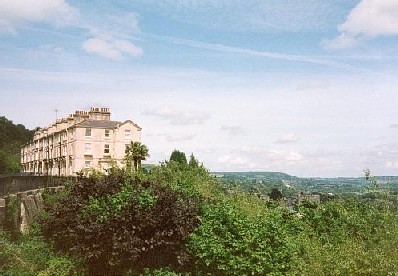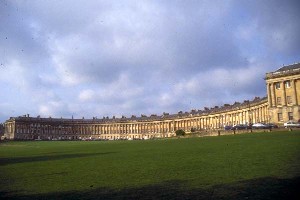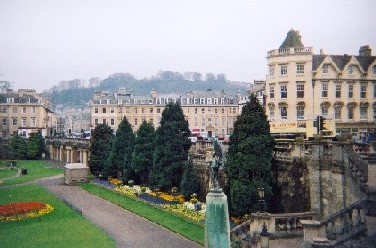 The golden age for Bath The golden age for Bath
I ran all the way back to tell Mother I'd spoken to Mr Repton.
She took the news very calmly, saying, she hoped he was as pleased speaking to me. She is always like this, very calm, a little amused at life, as well she might be, because life has treated her well, better than anyone might have expected....
|
The fabled city
So much has been said and written about Georgian Bath that it is hard to imagine one can add much. Yet this was a time of frantic urban expansion, of reckless investment in property, of grand dreams and crashing disasters. It is sad to discover that many of the texts refer just to the glorious buildings produced by this era, and leave out the poverty, the disease, the destruction of the previous medieval city, making little reference to the life led by those not fortunate enough to move in Ralph Allen's set. Just about the only trace of an angle in these gushing eulogies is a brief mention of Jane Austen's dislike of the place. I attempt to give a broad picture...corrections, as usual, to
Archsweet, please.
|
 The early schemes for Bath The early schemes for Bath
Visible in an early map of the city, which still shows a city wall and many late medieval gabled buildings, is a large building with elegant pediment and a distinctive severe look to it: the North side of Queen Square. The construction of the square (by John Wood the Elder) in 1728 marked the first major planned development outside the city walls. It brought an area of private land into public use, and originally was intended to feature civilised gravel walks and an obelisk rising from a pond in the centre. Traffic and trees were not in the design. The seven houses across the north side were arranged behind a unified grand facade, enabling men of limited means to live, apparently, in a palace.
 The palace idea caught on - who wouldn't want to lodge in a building with the elegance of those in Queen Square - at the price of a place a seventh the size? Soon terraced houses were being built in impressive ranges across Bath, drawn into unified designs by central pediments and graceful Palladian window layouts. The palace idea caught on - who wouldn't want to lodge in a building with the elegance of those in Queen Square - at the price of a place a seventh the size? Soon terraced houses were being built in impressive ranges across Bath, drawn into unified designs by central pediments and graceful Palladian window layouts.
In this period were constructed St John's Gate, now known as Trim Bridge (also 1728, and a major link from the old city into Queen Square); Beaufort Square (behind the current Theatre Royal); and Rosewell House, the unusual baroque building in Kingsmead Square - by Strahan, 1736.
 Encouraged by the success of his Queen Square scheme, Wood the Elder planned a second, more extravagant development between the Abbey and the river Avon: a grand forum, with paved streets between the houses, wich would form a double layer around a central square. North and South Parades and Pierrepont Street were duly built in 1740 - but the grand forum remained unfinished. Wood did, however, provide a new area, to be known as St James Triangle, for taking the air - now known as Institution or Parade Gardens, it sat below Harrison's Assembly Rooms, and was overlooked by the houses on North Parade. Encouraged by the success of his Queen Square scheme, Wood the Elder planned a second, more extravagant development between the Abbey and the river Avon: a grand forum, with paved streets between the houses, wich would form a double layer around a central square. North and South Parades and Pierrepont Street were duly built in 1740 - but the grand forum remained unfinished. Wood did, however, provide a new area, to be known as St James Triangle, for taking the air - now known as Institution or Parade Gardens, it sat below Harrison's Assembly Rooms, and was overlooked by the houses on North Parade.
Meanwhile, who did all the work on these developments, and how did the materials reach the city centre? To think of
 transporting Bath stone in such quantities from Combe Down, where it was mined, even today is nightmarish. With roads in muddy, potholed early eighteenth century conditions there was only one solution - not to bring the stuff by road. transporting Bath stone in such quantities from Combe Down, where it was mined, even today is nightmarish. With roads in muddy, potholed early eighteenth century conditions there was only one solution - not to bring the stuff by road. Ralph Allen owned mines up on Combe Down, and needed a cost effective way to move his stone to where it was needed. One innovation credited to him is the laying of rails from his mines to his wharf on the Avon, and employing horses to draw the stone-laden trains. From that point, water transport was simplest.
For great early modern history information, visit The
Modern History Internet Sourcebook: http://www.fordham.edu/halsall/mod/modsbook.html
|